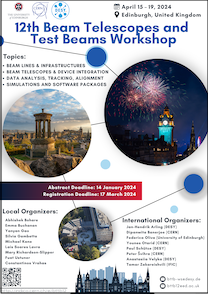Speaker
Description
Research and development of monolithic active pixel sensors (MAPS) with applications in future lepton colliders and beam telescopes face various challenges regarding time and position resolution while maintaining a low material budget and high rate capabilities. In this context, the H2M (hybrid-to-monolithic) project represents the joint effort of CERN, DESY and IFAE to design and test a monolithic chip with an integrated hybrid pixel detector architecture. This sensor was designed and fabricated in a 65nm CMOS imaging process and consists of $64 \times 16$ square pixels with a 35um pitch, which results in a total active area of $2.24\times 0.56$ mm$^2$. The n-gap layout of the sensitive area of this chip was previously investigated in the Tangerine project and ensures an improved charge collection from pixel edges and corners.
This contribution shows preliminary results of the laboratory characterization of an H2M prototype. A particular focus was put on the implementation of a trimming procedure by making use of the tuning DAC, as this front-end parameter allows for the threshold adjustment for individual pixels with a 4-bit resolution. Different procedures to minimize the threshold dispersion for the whole pixel matrix were tested, and the impact of the bias current of the tuning DAC was studied.
